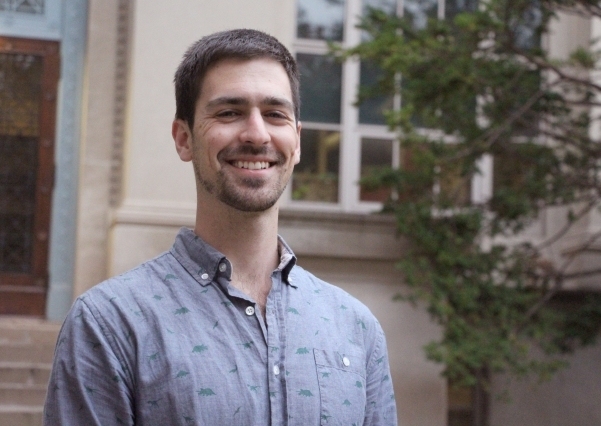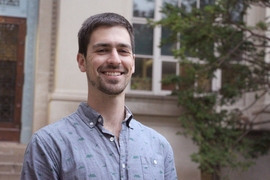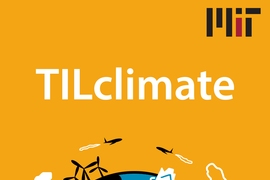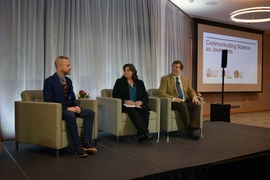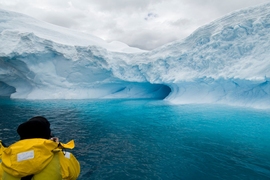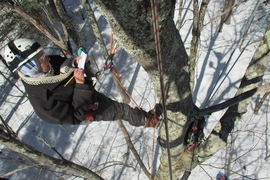On a Tuesday evening earlier this semester, before MIT began to de-densify its campus in response to the emergence of Covid-19, 10 students stood in three small circles and took turns somberly counting to 20. They started calm and low with the number one, then gradually added volume and heartfelt pauses as the counting progressed. Some students reached 20 with evocative, uplifting crescendos, while others muttered the number in quiet, sympathetic tones punctuated by silence at the end.
For this exercise, the numbers themselves weren’t important. Prompted to count in the rhythm and timbre with which one might give a wedding toast, a graduation speech, or a funeral eulogy, students were aiming to use their voices to set a tone and evoke emotion regardless of the words that were spoken. For these students, nearly all of whom come from engineering disciplines, this isn’t a frivolous exercise; it’s training. One day, they hope to use it to fight climate change.
Here in CMS.375 (Reading Climate Through Media), a humanities course that examines the media’s portrayal of global warming and the human stories that underlie this worldwide issue, crafting effective messages is a key component of the curriculum. Taught by James Paradis, the Robert M. Metcalfe Professor of Writing and Comparative Media Studies, and Brandon Leshchinskiy, the aeronautics and astronautics and technology and policy graduate student who led the counting exercise, the class centers around critiquing media ranging from documentary films to presidential speeches to nature poems, and on helping students develop oral and written communication skills they can use to drive their messages about global warming home.
“It’s important for the science to be there. It’s leading to new technologies and so forth, but the real problem is at the human level,” Paradis says. “That’s where the political and human stories [around climate change] all come into play.”
The goal of the class is twofold, Paradis adds. First, it’s designed to augment the many climate-focused science and engineering courses at MIT by digging into the social and cultural implications of global warming and by providing a more personal framework for thinking about these issues. Paradis says that the course is also meant to offer a practical outlet for the eco-anxiety many within the MIT community feel as the climate continues to warm.
“I want them to have the power to use media to express something about how they feel,” Paradis says. “I’m trying to open up a space for students to express their own ideas about global warming.”
In Paradis’ class, that expression takes a number of forms. In addition to comparing and critiquing climate texts across a broad spectrum of media formats, students write their own opinion/editorial articles, create environmentally-driven comics, and produce short YouTube videos on global warming topics. Those projects are supplemented by in-class communication workshops — tools future scientists, engineers, and policymakers can use to accurately and effectively capture the nuances of their work and make their voices heard.
Shortly after the emotion-evoking counting exercise, Paradis’ students applied these presentation techniques to their own work. One by one, each stood up and delivered a one-line summary of an opinion piece they had recently written for class, speaking the sentence as if they were giving an inaugural address. After a few embarrassed giggles, students shook off their jitters and delivered sincere messages on subjects ranging from regulating factory farm pollution to curbing private vehicle use.
Sandra Li, a third-year mechanical engineering student, addressed the environmental impact of the fast fashion industry. She spoke nervously at first, then gradually gained self-assurance, an effect of the class that she says has leaked into her work in other MIT courses and into her personal conversations.
“I find myself now being able to actually engage in talking with other people about this climate crisis,” she says. “I’m confident that I know enough to start talking about it and not feel ignorant about this issue.”
Li plans to go into product design after graduation. She’s long been interested in sustainability and has taken several related engineering courses, but didn’t feel like she had the full picture.
“There’s always a motive behind why we’re trying to come up with all these solutions and they’re not really talked about in engineering courses,” she says. “Humanities is probably the best place to get a good foundation and background.”
Reading Climate Through Media is part of a broader push within the MIT School of Humanities, Arts, and Social Sciences (SHASS) to address climate change from a humanities perspective. While the school has always focused on research and coursework that illuminates the world’s most pressing contemporary issues, over the past few years SHASS has significantly bolstered its roster of undergraduate and graduate classes on various aspects of the climate crisis.
"Climate change is a complex, multidimensional problem whose roots are deeply embedded in the human world — in the political, economic, technological, and cultural realities that are the focus of MIT’s humanistic research," says Melissa Nobles, Kenan Sahin Dean of SHASS. “That’s why combining advanced scientific and technical knowledge with an in-depth understanding of human systems has long been MIT’s approach to making progress on climate issues — and on all the major challenges of our time.”
For Maria Paula Barbosa, a second-year aerospace engineering major, understanding those human systems is key to climate mobilization. Barbosa says that studying different ways that climate is portrayed and honing her presentation skills in Paradis’ class has provided much-needed contextual knowledge and helped her become a more convincing speaker and sustainability advocate.
“The fact that climate change is often viewed as an engineering and economics problem is exactly why it is important to study it from a humanities perspective,” she says. "Oftentimes, people worry that an issue like climate change is so grand and beyond reach that their actions may not have as much of an impact. Appealing to people's emotions through a different perspective can help inspire passion and action.”
Instilling knowledge and empowerment is Paradis’ goal with Reading Climate Through Media. Regardless of future scientific or technological innovations, solving the climate crisis will come down to how humans choose to behave and what information they choose to hear. Saving humanity will ultimately be up to the messengers. “It’s not gonna happen unless we send out people to engage at the human level,” he says.
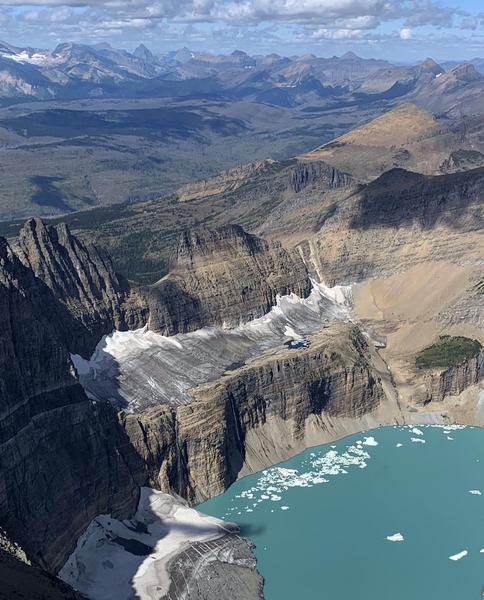
![“It’s important for the science to be there ... but the real problem is at the human level,” Professor James Paradis says of conveying the enormity of climate change to the public. “That’s where the political and human stories [around climate change] all come into play.”](/sites/default/files/styles/news_article__image_gallery/public/images/202004/Professor%2520James%2520Paradis.jpg?itok=pcf07Zzn)
